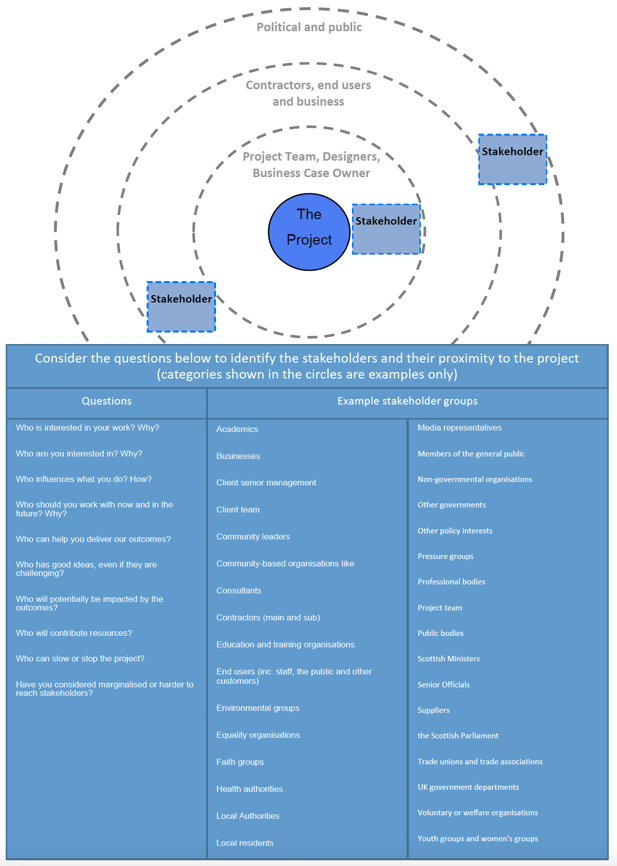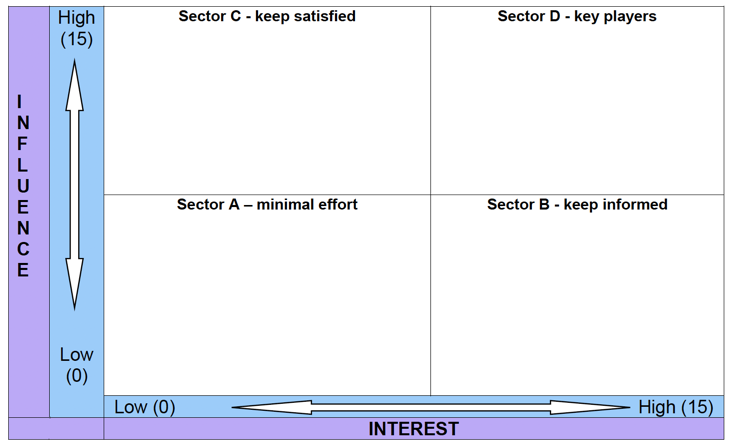Construction procurement: project initiation and business cases handbook
One of three handbooks that comprise the Client Guide to Construction Projects, The Project Initiation and Business Cases Handbook provides guidance to assist contracting authorities to successfully deliver construction projects and achieve value for money.
Chapter 6: Stakeholder Analysis
1. Introduction
2. Overview
3. Tools
4. Summary
Annex A: Stakeholder Mapping Tools
Annex B: Influence and Interest Matrix
Introduction
1.1. People are at the heart of every project and successful delivery of projects depends on the effectiveness of the engagement with them. It is often the case that project complexity derives from the complexity of the stakeholder environment rather than from the complexity of the construction of the physical asset itself, therefore time spent understanding the needs of stakeholders will be an investment in successful delivery. This requires the project sponsor and the project team to ensure that the stakeholder landscape is fully understood and engaged early on during project initiation.
Overview
2.1. Stakeholders are all those people and organisations which have some form of relationship with the project, the asset and the benefits delivered as a consequence of it. The nature of the relationships will be as diverse as the nature of the stakeholders themselves and understanding that diversity is central to being able to properly engage with them.
2.2. Engaging stakeholders serves a number of purposes including to:
- Define the purpose
- Develop the design
- Inform interested parties
- Influence debate
- Manage messages and people
- Promote inclusion
2.3. There are five steps to improving stakeholder relationships:
- Plan - think about what you want to achieve and whose views you want to consider.
- Build understanding – understand what motivates stakeholders, what they are thinking and what expertise they have.
- Engage – talk and listen to your stakeholders.
- Build trust – maintain relationships by taking on board stakeholders' suggestions and concerns.
- Evaluate – consider whether the engagement has been successful and what it means for the project and the next steps of engagement.
Tools
3.1. Tools are provided at Annex A and Annex B which will help clients understand the stakeholder environment as it relates to their projects.
Summary
4.1. Engaging with stakeholders is essential to project success and should be an ongoing activity from project inception and throughout the project period.
Annex A Stakeholder Mapping Tool

Annex B Influence and Interest Matrix
- 1. The influence/interest matrix is a useful tool for prioritising stakeholders once your initial mapping exercise is complete. It analyses:
- how interested the stakeholder is in impressing its views and expectations on what you are trying to achieve.
- whether the stakeholder has sufficient power to influence what you are trying to achieve.
- 2. This provides valuable information on how to work with particular stakeholders, and helps determine which stakeholders you need to prioritise.
Using the matrix
Influence: Score the level of influence each stakeholder can exert using the following assessment criteria (each criteria should have a maximum of five points, and a minimum of zero):
- How capable are they of influencing others?
- What's the risk posed by challenge from this stakeholder?
- Can they contribute to successful delivery?
Interest: Score each stakeholder's level of interest in your work using the following assessment criteria (each criteria should have a maximum of five points, minimum zero):
- How well established is the relationship?
- How active has the stakeholder been on this particular policy area?
- How keen is the stakeholder to express their views on the work you are doing?
Stakeholder |
Influence |
Interest |
||||||
|---|---|---|---|---|---|---|---|---|
Capacity to influenceothers |
Riskfrom challenge |
Contribution to delivery |
TOTAL SCORE |
Maturityof relationship |
Activity level |
Propensityto express views |
TOTAL SCORE |
|
[insert name] |
||||||||
[insert name] |
||||||||
[insert name] |
||||||||
[insert name] |
||||||||
[insert name] |
||||||||
[insert name] |
||||||||

Stakeholders in sector A have neither a high interest in the project nor the power to exert significant impact. You should keep these stakeholders informed as necessary, without investing too much effort into relationships with them.
Stakeholders in sector B have a high interest in specific areas of the project, but limited means of influence. Nonetheless, they could be valuable allies. It is therefore useful to keep them informed about the issues they are interested in.
Relationships with stakeholders in sector C could be difficult. They behave passively most of the time and show a low interest in the work you are doing. Despite this, they can exert an enormous impact if they see fit. It is therefore important to analyse the potential intentions and reactions of these stakeholders in all major developments, and involve them according to their interests.
The most important stakeholders are those with high interest and high influence in sector D. They must be involved in all relevant developments.
Contact
Email: ConstructionPolicy@gov.scot
There is a problem
Thanks for your feedback